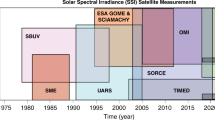Abstract
The apparent shape of the Sun is controversial1: Dicke and Goldenberg2 measured a Sun with an oblateness (equatorial minus polar radius divided by polar radius) of 5 × 10−5, whereas Hill and Stebbins measured a value of 0.9 × 10−5, consistent with a slowly rotating core. More recently, Claverie et al.3 have found the Sun's interior may be rotating faster than the surface after all. Dicke and Goldenberg's observations were questioned by Chapman and Ingersoll4 on the basis that facular influences could introduce a signal which appeared similar to the solar oblateness signal both in shape and magnitude. Dicke5 analysed the data in many different ways (such as dividing the data on the basis of facular brightness, and different window size) and concluded that the faculae did not contribute significantly. We reexamine this question by means of more general facular contrast models. We find that the faculae can contribute a signal which has a time dependence similar to the Dicke and Goldenberg oblateness signal, and which for a facular contrast within the range of acceptable values allows an acceptable fit to the oblateness measurements.
This is a preview of subscription content, access via your institution
Access options
Subscribe to this journal
Receive 51 print issues and online access
$199.00 per year
only $3.90 per issue
Buy this article
- Purchase on Springer Link
- Instant access to full article PDF
Prices may be subject to local taxes which are calculated during checkout
Similar content being viewed by others
References
Hill, H. A. & Stebbins, R. T. Astrophys. J. 200, 471 (1975).
Dicke, R. H. & Goldenberg, H. M., Rev. Lett. 18, 313–316 (1967).
Claverie, A., Isaak, G. R., McLead, C. P., van der Raay, H. B. & Roca Cortes, T. Nature 293, 443–445 (1982).
Chapman, G. A. & Ingersoll, A. P. Astrophys. J. 175, 819–829 (1972).
Dicke, R. H. Astrophys. J. 175, 831–835 (1972).
Sofia, S., Oster, L. & Schatten, K. Solar Phys. 80, 87 (1982).
Chapman, G. A. Astrophys. J. Lett. 242, L45–47 (1980).
Frazier, E. N. Solar Phys. 21, 42 (1971).
Chapman, G. A. Solar Phys. 14, 315 (1970).
Spruit, H. C. Solar Phys. 50, 269–275 (1976).
Author information
Authors and Affiliations
Rights and permissions
About this article
Cite this article
Schatten, K., Sofia, S. Facular influences on the apparent solar shape. Nature 301, 133–134 (1983). https://doi.org/10.1038/301133a0
Received:
Accepted:
Issue Date:
DOI: https://doi.org/10.1038/301133a0
This article is cited by
-
An analysis of 1983 observations of facular contrast with an extreme limb photometer
Solar Physics (1996)
-
Facular influences on the apparent solar shape
Nature (1983)
Comments
By submitting a comment you agree to abide by our Terms and Community Guidelines. If you find something abusive or that does not comply with our terms or guidelines please flag it as inappropriate.



